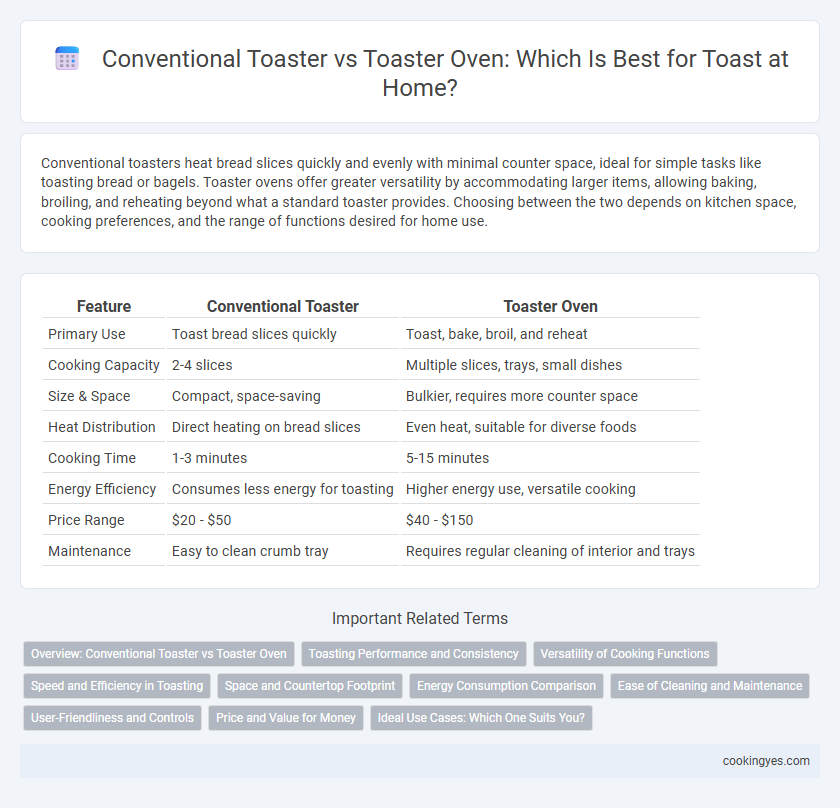Conventional toasters heat bread slices quickly and evenly with minimal counter space, ideal for simple tasks like toasting bread or bagels. Toaster ovens offer greater versatility by accommodating larger items, allowing baking, broiling, and reheating beyond what a standard toaster provides. Choosing between the two depends on kitchen space, cooking preferences, and the range of functions desired for home use.
Table of Comparison
| Feature | Conventional Toaster | Toaster Oven |
|---|---|---|
| Primary Use | Toast bread slices quickly | Toast, bake, broil, and reheat |
| Cooking Capacity | 2-4 slices | Multiple slices, trays, small dishes |
| Size & Space | Compact, space-saving | Bulkier, requires more counter space |
| Heat Distribution | Direct heating on bread slices | Even heat, suitable for diverse foods |
| Cooking Time | 1-3 minutes | 5-15 minutes |
| Energy Efficiency | Consumes less energy for toasting | Higher energy use, versatile cooking |
| Price Range | $20 - $50 | $40 - $150 |
| Maintenance | Easy to clean crumb tray | Requires regular cleaning of interior and trays |
Overview: Conventional Toaster vs Toaster Oven
Conventional toasters offer quick, even browning for standard slices of bread with minimal counter space usage, making them ideal for simple toasting needs. Toaster ovens provide greater versatility, accommodating a variety of foods such as bagels, pastries, and small casseroles, while also featuring adjustable temperature controls for baking and broiling. Both appliances differ in cooking methods and functional range, influencing their suitability based on user preferences and kitchen space.
Toasting Performance and Consistency
Conventional toasters deliver uniform and quick toasting with evenly distributed heat, making them ideal for consistently crisp bread slices. Toaster ovens provide more versatile heating options but may show variability in toasting consistency due to larger interior space and uneven heat circulation. Home users prioritizing reliable browning and speed often prefer conventional toasters for optimal toasting performance.
Versatility of Cooking Functions
A toaster oven offers greater versatility for home use, supporting a wide range of cooking functions including baking, broiling, and reheating, unlike a conventional toaster which is primarily designed for toasting bread. Its adjustable temperature controls and larger interior space allow users to prepare diverse meals such as pizzas, casseroles, and roasted vegetables. This multifunctionality makes the toaster oven a more flexible kitchen appliance for varied cooking needs.
Speed and Efficiency in Toasting
Conventional toasters heat bread slices rapidly with targeted heating elements, delivering consistent toast in under three minutes, ideal for quick breakfast routines. Toaster ovens provide versatility by accommodating larger quantities and various food types but typically require longer preheating and toasting times, reducing overall speed. Energy efficiency favors conventional toasters, as they consume less power per use compared to toaster ovens, which use more electricity due to heating a larger cavity.
Space and Countertop Footprint
Conventional toasters have a compact design, typically occupying less space on countertops and fitting easily into small kitchens, making them ideal for limited areas. Toaster ovens offer multifunctionality but generally require a larger footprint, combining baking, broiling, and toasting capabilities that demand more counter space. Choosing between the two depends largely on available kitchen space and the need for versatile cooking options.
Energy Consumption Comparison
Conventional toasters typically consume less energy, around 800-1500 watts, due to their focused heat delivery and shorter cooking times, making them more efficient for quick toasting tasks. Toaster ovens, using approximately 1200-1800 watts, provide versatility for baking and broiling but tend to use more energy because they heat a larger cavity and require longer operation periods. Home users seeking low energy consumption for basic toasting benefit from conventional toasters, while those needing multifunctional appliances may accept higher energy use with toaster ovens.
Ease of Cleaning and Maintenance
Conventional toasters feature removable crumb trays that simplify cleaning by collecting crumbs in one accessible spot, minimizing mess and maintenance. Toaster ovens often have larger interior spaces and baking trays that require more thorough cleaning, including wiping down surfaces to avoid grease buildup. Choosing a conventional toaster reduces cleaning time, while toaster ovens demand more regular maintenance due to their multifunctional design.
User-Friendliness and Controls
Conventional toasters offer straightforward operation with simple lever and dial controls, making them highly user-friendly for quick, consistent toast. Toaster ovens provide more versatile controls, including temperature settings and multiple cooking functions, which can be less intuitive but allow for broader use beyond toasting. User preference often depends on whether ease of use or multifunctionality is prioritized in home kitchens.
Price and Value for Money
Conventional toasters typically offer a lower upfront cost, making them an affordable choice for basic toast preparation. Toaster ovens, though priced higher, provide greater versatility by combining baking, broiling, and toasting functions in one appliance. For home use, toaster ovens deliver better value for money by maximizing functionality and reducing the need for multiple kitchen devices.
Ideal Use Cases: Which One Suits You?
A conventional toaster is ideal for quickly toasting slices of bread and bagels with consistent browning, making it perfect for users seeking fast, straightforward breakfast preparation. A toaster oven offers greater versatility, handling not only toast but also small baking, broiling, and reheating tasks, suited for those needing multifunctional kitchen appliances. Consider countertop space and cooking needs when choosing, as toaster ovens typically require more room while providing expanded cooking options compared to the compact convenience of conventional toasters.
Conventional toaster vs toaster oven for home use Infographic

 cookingyes.com
cookingyes.com